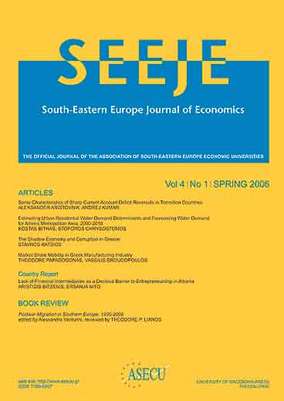Employment status for people with disabilities in Greece
Part of : SEEJE ; Vol.10, No.1, 2012, pages 25-40
Issue:
Pages:
25-40
Author:
Abstract:
This article reviews the status of individuals with disabilities in Greece, based on data from a primary research carried out within the framework of Community Initiative Programme (CIP) Equal. In particular, the article examines the features of people with disabilities, the relation of educational studies to occupation, and the factors which influence the decision to work. It investigates the interest of disabled people in working, their current and past employment status, the field and the duration of employment as well as the importance of several factors contributing to job-seeking. In addition the article examines the means exploited in the process of finding a job, attitudes while working, as well as comparing the performance of disabled people at work to that of other employees. The findings of the research reveal to a full extent the problem of exclusion of disabled people from employment and point out the need for initiatives on behalf of the state in order to provide some solutions to tackle the problem.
Subject:
Subject (LC):
Keywords:
disabled people, employment, Greece
Notes:
Περιέχει πίνακες και βιβλιογραφία, JEL Classification: J71
References (1):
- Chima O. Felix, 2005, “Persons with Disabilities and Employment: Implications for SocialWork and Rehabilitation Roles and Advocacy”, Journal of the Social Work in Disability &Rehabilitation, Vol. 4(3), p. 57.Cohen D.F.B., Zeitzer I.R., “How Governments Can Use Technology to Promote Employment ofPeople with Disabilities”, Lecture Notes in Computer Science, 3118, 2004, p. 45).Council Directive 2000/78/EC of 27 November 2000, “establishing a general framework for equaltreatment in employment and occupation”, Official Journal of EC (L 303, 02.12.2000).European Commission: Commission Communication of 30 October 2003 – Equal opportunitiesfor people with disabilities: a European Action Plan [COM (2003) 650] and CommissionCommunication of 28 November 2005 – Situation of disabled people in the enlarged EuropeanUnion: The European Action Plan 2006-2007 [COM (2005) 604].European Commission, DG Employment, Social Affairs and Equal Opportunities, 2007, “Men andwomen with disabilities in the EU: Statistical analysis of the LFS ad hoc module and the EUSilc”,p. 15, 39.European Commission, 2004, “Monitor social situation in the European Union 2004 (Observatory)”,p. 34.Eurostat, 2003, “Employment of disabled people in Europe in 2002”, pp. 1-3.Eurostat, Data 2003, “European Social Statistics Labour Market Policy Expenditure andParticipants”, p. 12, 14.Greek National Confederation of Disabled People, European Disability Forum, 2001, “Disabilityand Social Exclusion in the European Union Time for change, tools for change”, p. 14-15.ILO, 2007, “ILO calls for new efforts to support people with disabilities in the world work”.Magoulios, G. et al., 2003, “Primary Research on the employment status of people with disabilitiesexperiencing simple or multiple discriminations”, Equal project ‘Proklisi’, July-September2003, Greece - partner representatives: European Development S.A. Magoulios N. George,coordinator of the research project and in charge of the survey group, Trichopoulou Anna,Papadopoulou Eleni, National Confederation for People with Disabilities (ESAEA), ResearchCentre for Gender Equality (KETHI), Greek Manpower Employment Organisation (OAED),Organisation Against Drugs (OKANA), Panhellenic Association for the Blind (PST),International Organisation for Migration (IOM), Hellenic Association of Social Workers(SKLE) and Hellenic Federation for the Deaf (OMKE).National Statistical Service of Greece (NSSG), 2003 and 2001, Population Census.National Statistical Service of Greece (2003), Health and Inequality, Athens.Pope D., Bambra C., 2005, “Has the Disability Discrimination Act closed the employment gap?”,Disability and Rehabilitation 27 (20), p. 1263, 1265.Priestley Mark, “Why We Need to Work Together in the European Year of Disabled People”,Disability & Society, Vol. 17, No. 7, 2002, pp. 846-848.Randolph S. D., Andresen M. E., 2004, “Disability, gender, and unemployment relationships in theUnited States from the behavioural risk factor surveillance system”, Disability & Society, Vol.19, No. 4, pp. 411-412.Roulstone Alan, “Disabling Pasts, Enabling Futures? How Does the Changing Nature of CapitalismImpact on the Disabled and Jobseeker?”, Disability & Society, Vol. 17, No 6, 2002, p. 636.Russell Marta, “What Disability Civil Rights Cannot Do: employment and political economy”,Disability & Society, Vol. 17, No. 2, 2002, pp. 130-131.Schneider Justine & Dutton Jillian, “Attitudes Towards Disabled Staff and the Effect of the NationalMinimum Wage: a Delphi survey of employers and disability employment advisors”, Disability& Society, Vol. 17, No 3, 2002, p. 283 & 303.Stevens Geoff Ruggeri, “Employers’ Perceptions and Practice in the Employability of DisabledPeople: a survey of companies in south east UK”, Disability & Society, Vol. 17, No. 7, 2002,p. 779 and 792.United Nations (1993), “Standard Rules on the Equalization of Opportunities for People withDisabilities”, New York, United Nations.UN Human Rights, 2011, Lumina Cephas, Greek crisis: “Keep in mind the basic human rights ofpeople” - United Nations experts on the rights and foreign debt.




